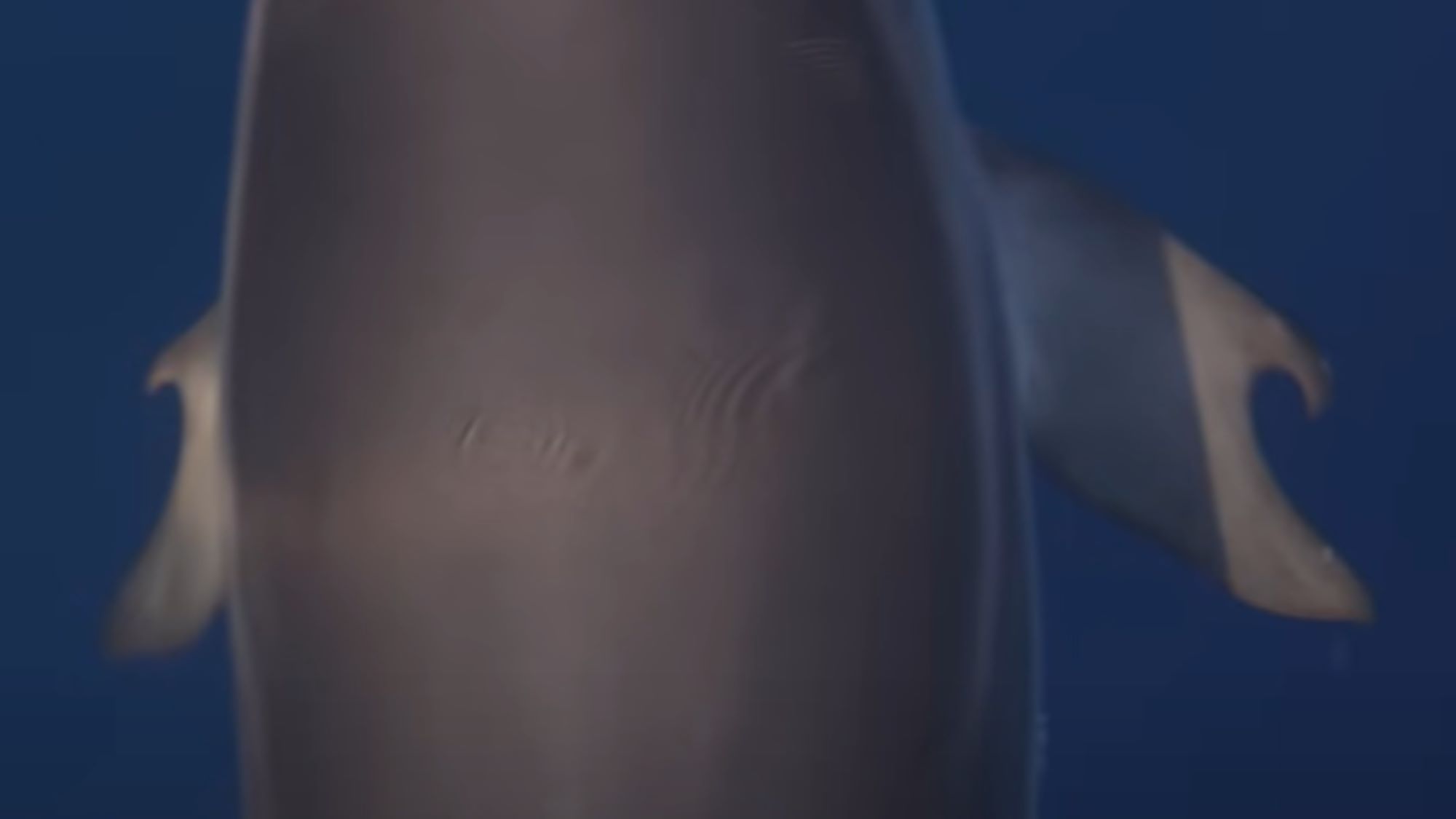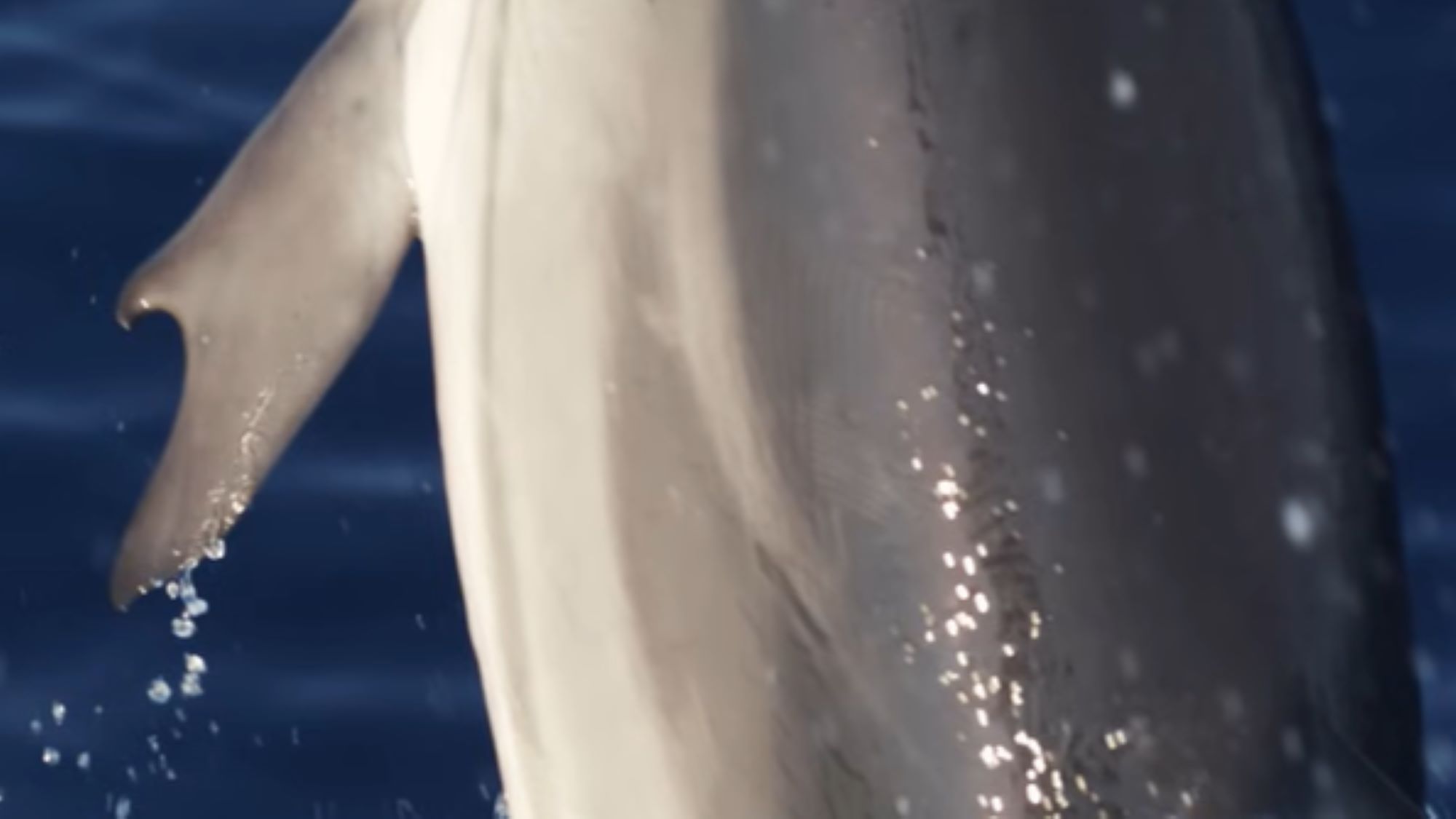Extremely rare dolphin with thumbs photographed in Greek gulf
A dolphin with deformed flippers that look like thumbs was spotted in the Gulf of Corinth in July 2023. It likely acquired what appears to be a genetic defect during development in the womb, experts say.

A strange dolphin in the Gulf of Corinth has developed intriguing, hook-shaped "thumbs" carved out of its flippers, photographs show.
Researchers with the Pelagos Cetacean Research Institute spotted the dolphin on two occasions this summer during boat surveys off the coast of Greece. Despite the unusual appearance of its flippers, the animal kept pace with the rest of its pod and was seen "swimming, leaping, bow-riding, playing" with other dolphins, said Alexandros Frantzis, the scientific coordinator and president of the Pelagos Cetacean Research Institute.
"It was the very first time we saw this surprising flipper morphology in 30 years of surveys in the open sea and also in studies while monitoring all the stranded dolphins along the coasts of Greece for 30 years," Frantzis, who took the pictures of the thumbed dolphin, told Live Science in an email.
The Gulf of Corinth is a semi-enclosed pocket of the Ionian Sea, sandwiched between the Greek mainland and the Peloponnese peninsula. It is home to a unique mixed-species society of dolphins that includes common dolphins (Delphinus delphis), Risso's dolphins (Grampus griseus) and striped dolphins (Stenella coeruleoalba). The thumbed specimen was a striped dolphin, Frantzis said.
Related: Watch a huge megapod of acrobatic spinner dolphins in incredible, rare video
Around 1,300 striped dolphins live in the Gulf of Corinth, where they are isolated from the rest of the Mediterranean population. The unusual flipper "does not look like illness at all," Frantzis said. Instead, it may be "the expression of some rare and 'irregular' genes" that cropped up due to constant interbreeding, he said.
Lisa Noelle Cooper, an associate professor of mammalian anatomy and neurobiology at the Northeast Ohio Medical University, agreed that the dolphin's defect is likely rooted in its genes. "I've never seen a flipper of a cetacean that had this shape," Cooper told Live Science in an email. "Given that the defect is in both the left and right flippers, it is probably the result of an altered genetic program that sculpts the flipper during development as a calf."
Sign up for the Live Science daily newsletter now
Get the world’s most fascinating discoveries delivered straight to your inbox.

Cetaceans — a group of marine mammals that includes whales, dolphins and porpoises — have evolved distinct forelimbs with more phalanges, or finger bones, compared with other mammals. These bones are arranged into human-like "hands" encased in a soft-tissue flipper, said Bruna Farina, a doctoral student specializing in paleobiology and macroevolution at the University of Fribourg in Switzerland.
This means dolphins have thumbs, although they aren't as prominent as ours and are concealed by their flippers, Farina told Live Science in an email.
Unlike in humans, whose fingers are fused into paddle-shaped hands in the womb with cells that die off before we are born, cells accumulate around dolphins' forelimb bones to form flippers, Cooper said. "Normally, dolphins develop their fingers within the flipper and no cells between the fingers die off," she said.
But the dolphin photographed in the Gulf of Corinth appears to be missing fingers and some of the tissue that would usually encase them. "It looks to me like the cells that normally would have formed the equivalent of our index and middle fingers died off in a strange event when the flipper was forming while the calf was still in the womb," Cooper said.
The dolphin's thumb and fourth digit, however, remained. "The hook-shaped 'thumb' may have some bone inside of it, but it certainly isn't mobile," Cooper said, adding that "no cetaceans have mobile thumbs."
"It is lovely to see that this animal is thriving," Cooper added.

Sascha is a U.K.-based staff writer at Live Science. She holds a bachelor’s degree in biology from the University of Southampton in England and a master’s degree in science communication from Imperial College London. Her work has appeared in The Guardian and the health website Zoe. Besides writing, she enjoys playing tennis, bread-making and browsing second-hand shops for hidden gems.










